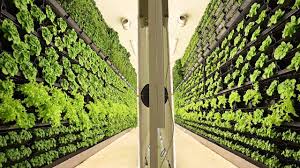

Vertical Farming is the practice of growing crops in vertically stacked layers. It often incorporates controlled – environment agriculture which aims to optimize plant growth, and soil less farming techniques.
There are 4 critical areas in understanding how vertical farming works:
1. Physical Layout.
2. Lightning.
3. Growing Medium and
4. Sustainability features
Physical Layout – The primary goal of vertical farming is producing more foods per square meter. To accomplish this goal, crops are cultivated in stacked layers in a tower life structure.
Lightning – A perfect combination of natural and artificial lights is used to maintain the perfect light level in the room. Technologies such as rotating beds are used to improve lightning efficiency.
Growing Medium – Instead of soil, aeroponic, aquaponic, or hydroponic growing mediums are used. Peat moss or coconut husks and similar non – soil mediums are very common in vertical farming.
Sustainability – The vertical farming method uses various sustainability features to offset the energy cost of farming. In fact, vertical farming uses 95% less water.
Types of Vertical Farms
1. Vertical farms in buildings – Abandoned buildings are repurposed for vertical farming, but it’s not necessary that such buildings be used often. Depending on the requirements new buildings are also used to construct vertical farms.
2. Shipping Container Vertical Farms – Old or recycled shipping containers are equipped with LED lightning, vertically stacked farms, climate controls and monitoring sensors. Such types of farms can save space and get a higher yield in the process.
3. Underground Vertical Farms – Also known as “Deep Farms”, these types of vertical farms are built in underground tunnels, abandoned mine shafts or any subterranean environment. Such Farms can produce 7 to 9 times more food than a conventional farm.


NEED TO KNOW MORE OR HELP WITH A PROFESSIONAL AND WELL – STRUCTURED BUSINESS PLAN? CONTACT US NOW ON -(27)84 583 3143 OR SEND US A EMAIL – money@global.co.za